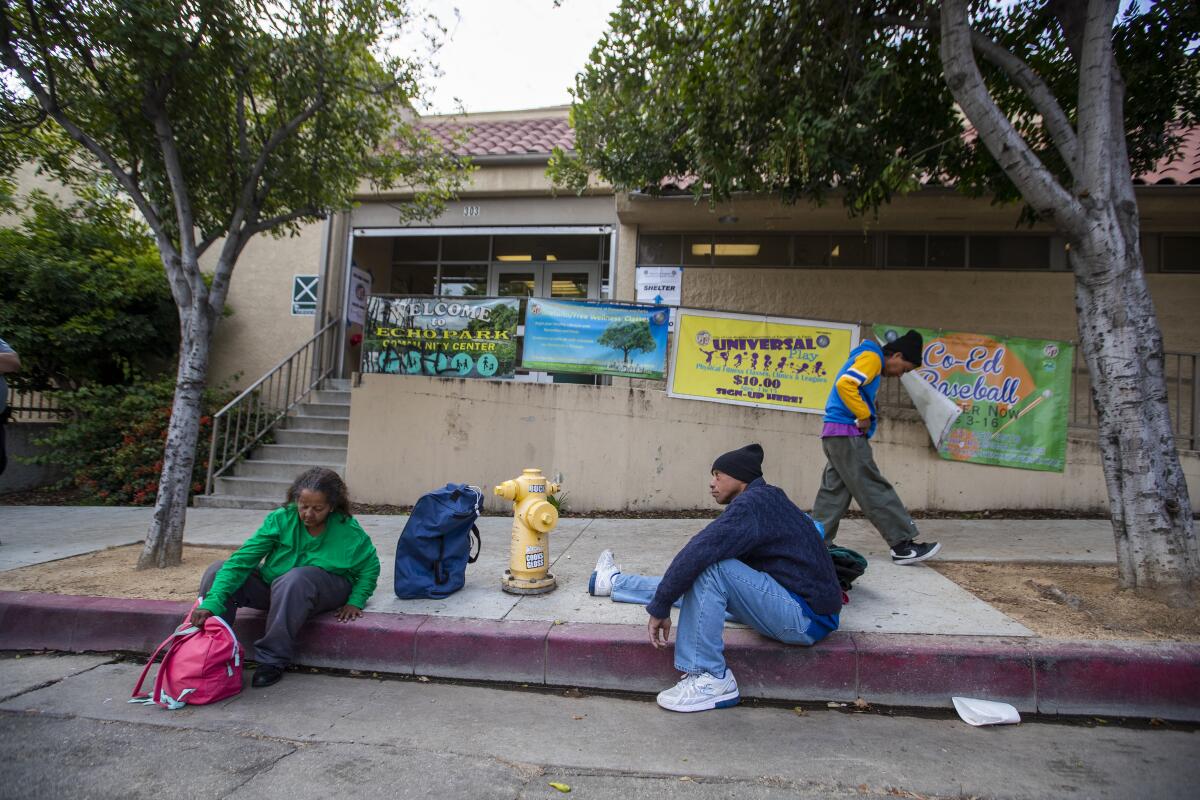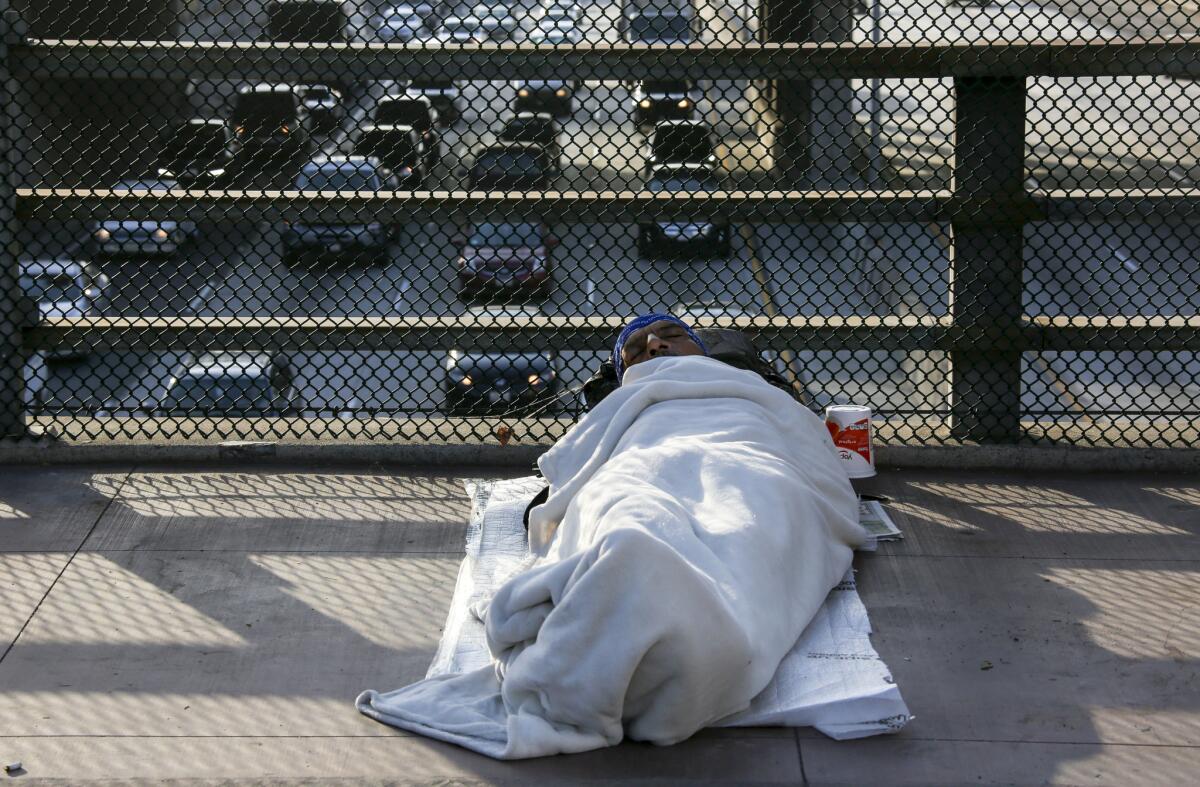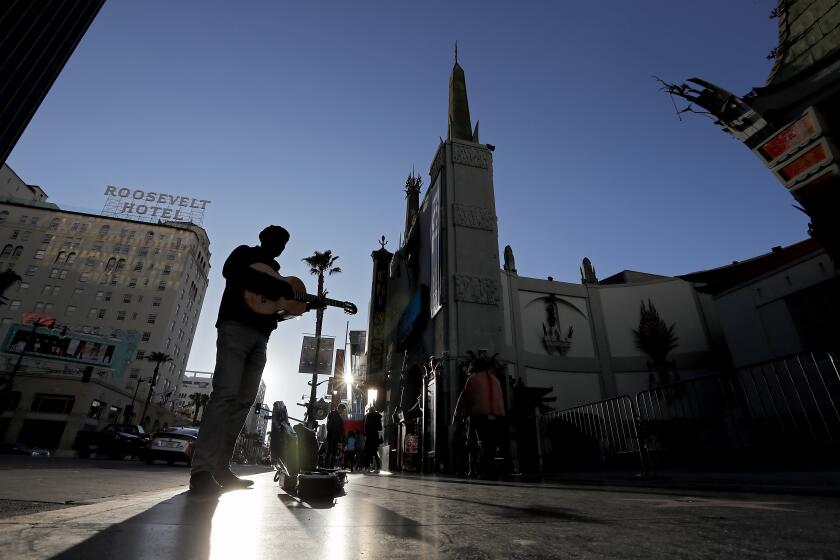California scrambles to shelter homeless before the coronavirus floods hospitals

- Share via
SACRAMENTO — Novel coronavirus and homelessness are colliding, forcing California leaders to launch the unimaginable — a massive effort to move those on the streets into hotels, motels and shelters within days to protect both them and a healthcare system that COVID-19 could soon overwhelm.
State models show that 60,000 homeless people could be hit by the novel coronavirus in the next eight weeks, with up to 20% of them needing hospitalization.
That would mean California would need 12,000 hospital beds just for those living on the streets — a formidable task for a state that is already struggling to find extra capacity to manage the pandemic before it’s too late and hospitals become overcrowded and unsafe with too many patients.
To avoid that prospect, the governor has directed local governments to procure hundreds of facilities statewide — hotels, motels, recreation centers — to house the most vulnerable. Some cities and counties are already moving forward.
Here’s a visual look at how life in Southern California has changed during the coronavirus crisis.
“This is essentially a threat to the population generally,” said Los Angeles County Supervisor Mark Ridley-Thomas, co-chair of Gov. Gavin Newsom’s statewide task force on homelessness. “It is not uncomplicated and it’s certainly not for the faint of heart, but we have an obligation to address this. Otherwise the matter worsens.”
The complications are likely to involve overcoming neighborhood resistance to emergency shelters, and encouraging homeless people to take refuge there. Yet Newsom has argued the state has little choice but to move on the plan, and move quickly.
“That creates a deep point of anxiety for the existing population, but moreover for our healthcare delivery system,” Newsom said Wednesday evening. The governor earlier said that one homeless person has already died of COVID-19 in Santa Clara County, but health officials there have not released details.
The state estimates that surge capacity in California’s existing hospital system could accommodate 10,000 patients. If requests for military medical assistance are granted, including a request Thursday that the Mercy, a Navy medical ship, be deployed to Los Angeles, California should be close to reaching the 20,000-bed threshold that some models predict could be needed, Newsom said.
But with 108,000 people living outdoors in California, many older, with weakened immune systems and preexisting conditions, Newsom and health officials are also dramatically stepping up efforts to curtail what was the state’s biggest crisis before the novel coronavirus hit: tens of thousands of people living in street encampments with poor sanitation and crowded conditions.

There is much the state does not know — including how many homeless are already infected, and how isolation measures will work in a population with many underlying problems. But there is widening alarm about the threat to people already impaired by street conditions, sickness and addiction.
“People experiencing homelessness are among the most vulnerable to the spread of COVID-19,” Newsom said. “Helping these residents is critical to protecting public health, flattening the curve and slowing the spread of COVID-19.”
To help accomplish that, Newsom on Wednesday announced $150 million in emergency funding. The governor said $100 million will go directly to local jurisdictions — including Los Angeles — to boost shelter capacity and increase emergency housing.
An additional $50 million will be aimed at buying travel trailers and leasing hotels, motels and other facilities in an effort to provide space for those without homes to practice social distancing or be quarantined if they test positive for the virus or have symptoms of COVID-19.
Newsom said that about 950 properties statewide had been identified, and more than 1,300 trailers had been purchased from the Federal Emergency Management Agency and private vendors to serve as isolation sites and emergency housing.
But the gargantuan effort is far from certain to work, and presents hurdles that have never been dealt with before. For the last few years, local jurisdictions have struggled to open shelters and create housing without the pressure of immediate action — often with limited success.
“There are a lot of challenges in this idea,” said Elizabeth Bowen, an expert on homelessness at the University at Buffalo, State University of New York. “We’ve never had to try something like this before.”
The latest maps and charts on the spread of COVID-19 in California.
Barbara DiPietro, policy director for the National Health Care for the Homeless Council, said many contracts have already been signed with hotels and motels and facilities are expected to be up and running in matter of days.
In Los Angeles, Mayor Eric Garcetti announced Wednesday the city will convert 42 of its recreation centers into temporary shelters for homeless residents, providing 6,000 new beds, as part of the effort. The first beds in 13 recreation centers are set to open Friday.
Trent Rhorer, executive director of San Francisco’s Department of Human Services, said the city is adding 2,500 shelter spaces for the homeless and 3,500 hotel rooms for people who need to quarantine but have no place to do so. Many of the hotel rooms will go to people who live in single-occupancy hotels with shared bathrooms and kitchens. San Francisco has about 8,000 homeless.
Rhorer said the city expects to have leases for 500 rooms by the end of the week, and hotels with more than 2,000 rooms have expressed interest in leasing.
Bowen and others said that beyond procuring the sites, the logistics of the endeavor are daunting — moving thousands of people quickly to sites that are not yet set up to handle them.
“Manpower is a real issue,” DiPietro said.
She added that existing shelters and providers were already struggling to implement social distancing and other guidance that state and federal authorities have handed down. Now they are scrambling to handle the new model with staff and volunteers who are scared and, in some cases, not showing up.
Some have suggested that the governor call in the California National Guard to assist. Newsom this week alerted the Guard it may be called to support local and state agencies impacted by the COVID-19 outbreak and subsequent containment efforts, but has not suggested it be used for homeless efforts.
Ridley-Thomas said that existing county staff in Los Angeles could be directed to assist.
“It is a mistake to say we don’t have the capacity or the infrastructure,” Ridley-Thomas said. He added that under a state of emergency, the assignments of employees in various departments “are readjusted and appropriately so.”
Bowen pointed out that even with resources, homeless people may not want to move, or understand the necessity.
“A lot of homeless people ... have a distrust of authority,” she said. “Even during an emergency situation like this, to explain to people what is happening and why they are being asked to move into a hotel, it may be hard.”
DiPietro pointed out that many on the street have mental health concerns, and some may have substance abuse issues that make it difficult for them to self-isolate. Even if authorities manage to move unsheltered people indoors, keeping them there could prove difficult. In Seattle, a homeless man was quarantined at a hotel but later left and got on a city bus. Forcing people to move will probably not be successful, DiPietro said.
“Eventually, basically your guy runs away and then you don’t know where he is,” she said.
Before the coronavirus spread statewide, California faced a continuing quandary in housing the homeless: neighborhood and community resistance to creating new shelters.
Whether that changes now remains to be seen.
According to sources, a motel in Burlingame, on the San Francisco Peninsula, is one site authorities hope to use to house people. A visit to the motel Thursday revealed no apparent customers, and workers putting in new industrial carpeting.
When asked if the motel was being prepped for use during the COVID-19 outbreak, the manager declined to either confirm or deny, shaking her head when asked if a room could be booked for the night.
In some places, mayors and local authorities have been called on to use emergency powers granted by the governor to site shelters without community consent. Ridley-Thomas said he believed a state mandate, requiring cities to act and also granting local jurisdictions the power to force homeless people to move, may be necessary.
But for now, authorities are largely relying on the same message that has been used with success in social distancing: It’s time to think of the greater good.
“It is imperative at this time that all steps are taken to treat and care for individuals who are sick, and decrease the further spread of infection,” said Kate Rosenquist, a Burlingame resident and stay-at-home mother whose neighborhood may include a repurposed hotel.
“If a hotel is empty and the right precautions are in place, it only makes sense that the affected homeless are housed and treated there,” she said. “Our community needs to be supportive of helping those in need during this impossible crisis.”
Times reporters David Zahniser, Laura J. Nelson and Dakota Smith contributed to this story. Chabria reported from Sacramento, Rust from the San Francisco Peninsula and Dolan from Orinda.
More to Read
Sign up for Essential California
The most important California stories and recommendations in your inbox every morning.
You may occasionally receive promotional content from the Los Angeles Times.















